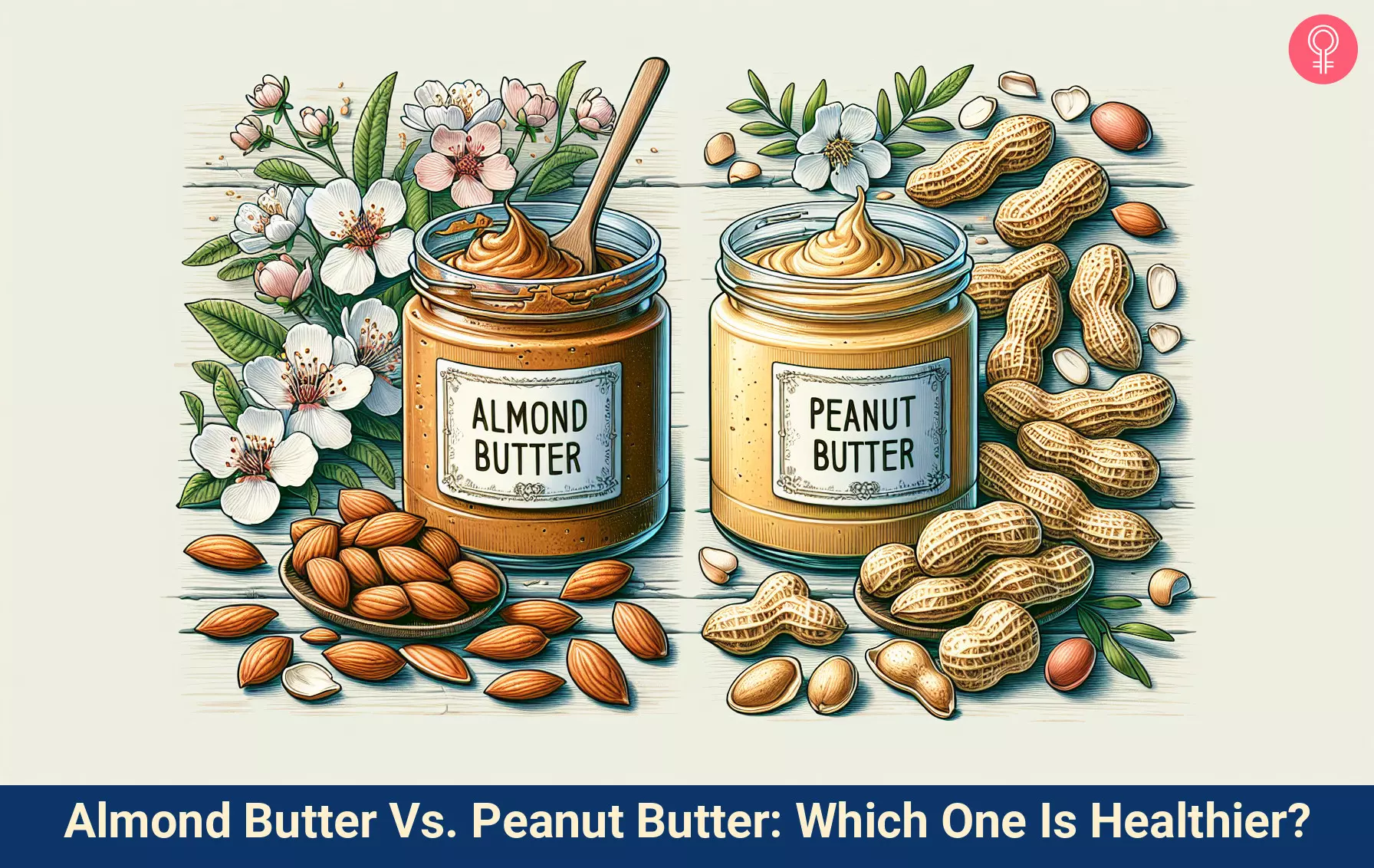Almond Butter Vs. Peanut Butter: Nutritional Comparison
Almond and peanut butter are rich in essential nutrients, fats, and other nutrients. However, one of them is healthier than the other on a nutritional basis. A tablespoon (16 g) of almond and peanut butter contain (1), (2) : From a nutrition perspective, both appear almost similar. However, almond butter remains ahead on certain important aspects. If you still can’t decide on which one to choose, scroll down to the next section.
Peanut Butter Vs. Almond Butter: Which One Is Better?
In terms of calories, both are almost the same. However, almond butter has more vitamins, minerals, and fiber than peanut butter. Almond butter has more calcium, potassium, magnesium, phosphorus, and vitamin E for roughly the same number of calories. Moreover, it also has 25% more healthy monounsaturated fats than peanut butter. Almond butter has more fiber than peanut butter. Fiber increases satiety, which may help in weight management. On the other hand, peanut butter has slightly more protein than almond butter. It is affordable and is preferred for regular or bulk use. However, peanuts belong to the legume family and grow under the earth. This makes them susceptible to aflatoxin contamination, a toxic mold that is carcinogenic to humans. So, ensure the peanut butter that you buy is free from this compound. Also, if you are looking for more nutrients for calories consumed, almond butter wins the battle. Irrespective of your choice, both almond and peanut butter have several benefits. Let’s check them out in the next section.
Health Benefits Of Almond Butter And Peanut Butter
Almond butter benefits range from supporting weight management to promoting healthy skin due to its high levels of healthy fats and vitamins. The same goes for peanut butter. Here are some top health advantages:
1. Promote Weight loss
Foods that promote satiety may help in weight management. Both peanut and almond butter are rich in protein, and fiber, making you feel full faster. Moreover, studies found that adding nuts to your diet could reduce the risk of obesity (3), (4).
2. Boost Heart Health
Nuts and peanuts are rich in cardioprotective nutrients that keep your heart healthy. Nutrients like monounsaturated and polyunsaturated fatty acids, vitamin E, niacin, and magnesium in peanuts and almonds reduce the risk of heart diseases. Peanut butter also improves lipid profile and helps in weight control in people with diabetes (5), (6).
3. Manage Blood Glucose Levels
Unsweetened peanut or almond butter has a low impact on blood glucose levels. A study showed that women who consumed nuts had lower blood sugar levels and more satiety than women who had the same carbs but no nuts (7). Type 2 diabetes is often linked to magnesium deficiency (8). Both almond and peanut butter are good sources of magnesium and, thus, improve insulin resistance. However, further research is required to verify this claim.
How To Make Almond Butter And Peanut Butter
Almond Butter Recipe
Ingredients
4 cups of almonds, unsoaked 2 tablespoons of neutral oil like avocado or vegetable oil (optional)
Instructions Extra Tips
You may add a pinch of sea salt, cinnamon powder, a bit of honey (as per your taste) to add flavor to the almond butter.
Now savor this alternative dish, altogether distinct from your typical snack options!
Peanut Butter Recipe
Ingredients
2 cups of peanuts, regular or dry roasted 1 tablespoon of honey (optional) 1 teaspoon of sea salt (optional)
Instructions Brooke McMillan, a cook and a blogger, prefers almond to peanut butter and shares the following to urge others on: “If you’ve never tried almond butter before, then I urge you to give it a try! I used to be a faithful peanut butter lover until I first tried it, and now I’m addicted to almond butter (i).” This is easy, right? Now, you can always enjoy the butter on a piece of toast, but we got some interesting recipes you can make with them! Scroll down.
Recipes To Try With Almond Butter And Peanut Butter
We know that the benefits of almonds and peanuts are many, including improving heart health, boosting brain function, and providing a rich source of antioxidants. These benefits are carried over to their butter form as well. You may use various recipes with them. Some are mentioned below.
1. Dairy-Free Almond Butter Icecream
Ingredients
1½ cups of unsweetened almond milk (or any non-dairy milk) 1 cup of pitted dates 1 cup of almond butter 1 teaspoon of salt 2 teaspoons of almond extract (optional) 1 teaspoon of vanilla extract or ¼ teaspoon of ground vanilla bean ½ cup of dried cherries/cocoa nibs/almonds for garnish
Instructions
2. Peanut Butter Pork Toast
Ingredients
1 tablespoon of peanut butter 1 slice of crusty bread 2 tablespoons of cooked and shredded pork 1 teaspoon of chili sauce, preferably sriracha 1 jalapeno pepper, thinly sliced A pinch of curry powder (optional)
Instructions If you are a little more hungry you can turn it into a sandwich– all you need is another slice of bread. These are some interesting and savory ways to have regular peanut and almond butter. However, check for possible allergies before you consume peanut and almond butter.
Possible Side Effects Of Almond And Peanut Butters
If you have a nut allergy, avoid peanuts and almonds. Peanuts are responsible for the majority of severe food-related allergic reactions compared to almonds. Though it is rare, those who are allergic to peanuts may also be allergic to almonds. It may cause the following symptoms (9),(10), (11):
Rashes Swelling Tightness in throat Cough Wheezing Nasal congestion Vomiting Diarrhea Stomach pain Low blood pressure Irregular heartbeat Cardiac arrest
These potential side effects might prompt you to explore alternative options to nut butters. Let’s look at some substitutes for peanut butter below.
Alternatives For Peanut Butter
You can use several nutritious and delicious options in place of peanut butter. These include:
The Verdict
Which nut butter is healthiest? Almond and walnut butters are the healthiest nut butters. They are rich in healthy fats and omega-3 fatty acids that positively affect overall health. Can I substitute peanut butter for almond butter? Yes, peanut butter can be an ideal substitute for almond butter. Both have a similar nutritional profile. Can almond butter and peanut butter be used interchangeably in recipes? Apart from recipes that require specific peanut butter or almond butter, these two can be used interchangeably in baking and cooking. Are there any variations of almond butter or peanut butter, such as crunchy or flavored options? Yes, there are many options available for both peanut and almond butter in terms of texture and flavor. You can pick crunchy, smooth, salted, unsalted, or raw butter. There are flavored peanut butter and almond butter options available flavored with cinnamon, chocolate, or honey. How should almond butter and peanut butter be stored to maintain freshness? To store your almond or peanut butter, use an air-tight container, refrigerate it after opening the container, store it in a cool dry place, and stir well before every use. Can almond butter or peanut butter help with muscle recovery after workouts? Both almond and peanut butter contain healthy fats, protein, and other nutrients, making it a good post-workout choice. However, a balanced diet is required to aid muscle recovery; just the butter won’t suffice.
Illustration: Almond Butter Vs. Peanut Butter: Which One Is Healthier?
Curious about the differences between peanut butter and almond butter? Watch this video to find out which one is healthier and tastier. Delve into the ultimate nut-butter debate now.











